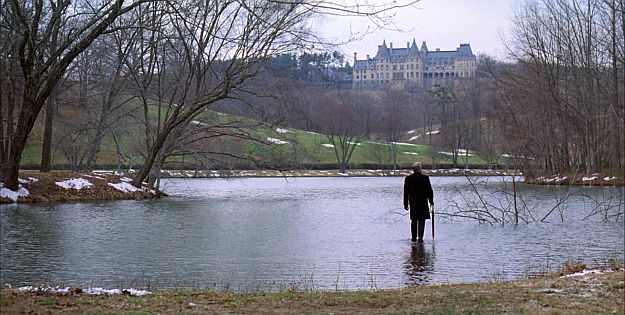
Peter Sellers, as "Chance, the gardener," a.k.a "Chauncey Gardner," walks on water at the end of Being There, a 1979 satire shown at this year's Maine International Film Festival in honor of its late director, Hal Ashby. More…
Highlights from this issue…
- MIFF 2018: Let This Be The Year To Go
- MIFF @ 21: Film Festival Returns to Downtown Waterville
- French Actress to Receive MIFF's Lifetime Achievement Award
- Remembering Alan Charles And His Love of the Lakes
- A Village Stroll in 1959, Part I
- Destiny and Power
- So What Is Erosion Control Mulch?
- Fishing and Hiking and Kids' Camps
Download Full Print Edition [PDF] • Links to Other Pages on This Site
MIFF 2018: Let This Be The Year To Go

Early organizers, still organizers: Alan Sanborn (L) and Ken Eisen in an archival photo.
The Maine International Film Festival: This is the weekend (July 13) that a unique opportunity for moviegoing returns to central Maine for ten days, when films from all over the world, the country, the state congregate into one streamlined schedule, one celebration of producers, directors and actors, one occasion when anyone can obtain a ticket and embark on a tradition of being part of MIFF.
Being part of MIFF, mingling with an impressive representation of the film industry, standing in line with diverse and devoted MIFF followers and casual moviegoers, watching films and attending events, that's what keeps MIFF strong, consistent and successful and that's what launched it.
In 1998 the first Maine International Film Festival was introduced. The 10-day event included workshops, seminars, a great logo of the mountains, the moon, the stars and a reel above, and over 30 carefully selected films. The early organizers — some of whom are still highly involved — documented audience reaction as an indication of what people in Maine really wanted from a film festival.
They wanted the films they wouldn't ordinarily get to see and they wanted the people behind the films who they wouldn't ordinarily get to meet. They wanted current previews and premieres and winners from other film festivals, and they wanted the historic, the lesser known, the early greats they thought they would never get to see, and the nostalgic reruns.
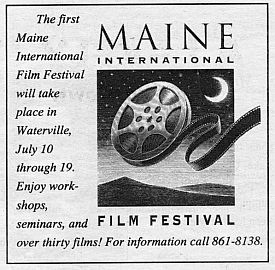
But what filmgoers wanted most in a festival, in MIFF, those first reviews showed, was accessibility: the world coming to Waterville, Maine films on the schedule, locations constant, and showings reliable. Over the years, MIFF retained all of the above and added much more, expanding to nearly 100 films, adding more and more special guests, live music, parties, awards, more and more pass holders, volunteers, regulars, one-nighters.
Now in its 21st year, MIFF is providing all the basics that have made it great and the conveniences of ever-increasing electronic access. There are many packages, passes, etc. for Miff-long film enjoyment and there is the option to just hop in the car and spend an evening with MIFF. It is the latter that summer visitors and vacationers are encouraged to do. Get up off the dock, dress casual, eat later — in company with some unexpected film shakers and movers.
This is the year, the summer, the season to take advantage of a unique opportunity, to start a personal or family tradition, to delve into the world of film, a world that does not have to be pursued since it is as close as Waterville's Railroad Square Theater and historic Waterville Opera House. This is the year to go — to discover and enjoy — the Maine International Film Festival.
Print Article • Go to Top of Page
MIFF @ 21: Film Festival Returns to Downtown Waterville

Emily Mortimer as bookstore owner Florence Green in The Bookshop, MIFF's opening film.
If you like fine films, Friday the Thirteenth is your lucky day! That's when the 21st annual Maine International Film Festival starts its ten-day journey into worlds both real and make-believe. And now that MIFF is of legal age, anything can happen!
With screenings at Railroad Square Cinema and the Waterville Opera House, the festival offers movie goers who aren't into car chases and explosions and who don't mind reading subtitles a chance to indulge their passion for films both new and old, foreign and domestic — from beloved classics, to forgotten masterworks, to brand-new features, some of which will have their world or North American premieres at the festival.
The key events of the festival's first seven days are the opening ceremony on Friday, the Lifetime Achievement Award presentation on Sunday, and the Centerpiece Gala on Wednesday. All three events take place at 6:30 p.m. in the Waterville Opera House. During that week, the festival will also pay homage to late movie director Hal Ashby and will uncover a new batch of "rediscoveries," i.e. unjustly overlooked classics, many in newly restored 35 mm prints or in digital reincarnations.
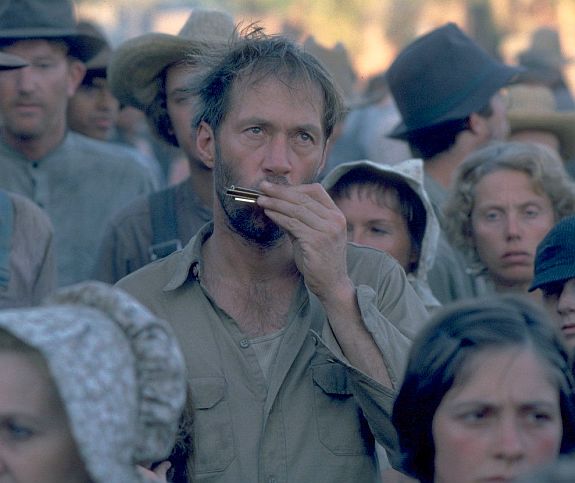
David Carradine, center, playing harmonica, as Woody Guthrie in Bound for Glory (1976).
It may seem ironic, but the festival's opening film is a paean to the written word. Set in 1959, The Bookshop follows the struggles of a plucky, young-ish widow (Emily Mortimer) to bring enlightenment through novels like Vladimir Nabokov's Lolita and Ray Bradbury's Fahrenheit 451 to the residents of a conservative English town who aren't sure that they want to be enlightened. She is politely but relentlessly opposed by the local matron of the arts (Patricia Clarkson), but befriended by an older, book-loving widower (Bill Nighy).
According to the MIFF website, "The Bookshop is an elegant yet incisive rendering of personal resolve, tested in the battle for the soul of a community. [Director] Isabel Coixet's gentle, charming, and thoroughly principled new English-language film walked away with most major awards at her native Spain's Oscar-equivalent Goya awards including Best Picture, Best Director, and Best Screenplay."
Later that evening, at 9:30 in Cinema 1, audiences can get their first look at Hal, a new documentary about Hal Ashby, who died thirty years ago this December. An anti-authoritarian director — if that's not an oxymoron — Ashby brought us a string of classic films of the 1970s, including Harold and Maude, Being There, Coming Home, and Bound for Glory. The documentary Hal explores his life and work through archival footage and interviews with people who knew him. It will have a second showing on Monday at 6:30.
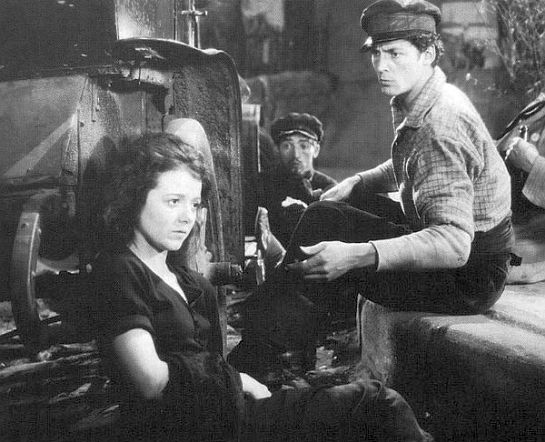
Janet Gaynor and Charles Farrell (right) in 7th Heaven (1927).
MIFF's Hal Ashby retrospective also includes Being There, his 1979 satire starring Peter Sellers as "Chance, the gardener," a simple man who is mistaken for a sage and winds up as an adviser to a political power broker, and Bound for Glory, his 1976 adaptation of folksinger Woody Guthrie's eponymous autobiography about his early years before he found fame. Being There screens Tuesday, July 17, at 9:30 and Sunday, July 22, at 3:30, and Bound for Glory will be shown Thursday, July 19, at 3:30. All three screenings will be in the Waterville Opera House.
On Sunday, MIFF will present its Lifetime Achievement Award to French actress Dominique Sanda. Each year, MIFF presents Lifetime or Mid-Life Achievement Award — the designation depends on the age of the recipient — to an actor, director, screenwriter, or other professional filmmaker. Last year's honoree was actress and model Lauren Hutton, and previous winners include actors Michael Murphy, Glenn Close, Keith Carradine, Malcolm McDowell, John Turturro, Ed Harris, Peter Fonda, and Sissy Spacek; directors Robert Benton and Jonathan Demme; and writer Terrence Malick. The award presentation will follow of screening of Sanda's best-known film, The Garden of the Finzi-Continis (1971).
This year's Centerpiece Gala on Wednesday is simultaneously a film screening and a concert. The film is 7th Heaven, a 1927 silent romance in which a Parisian street sweeper (Charles Farrell) interrupts a suicide attempt by a desperate young woman (Janet Gaynor) and two gradually fall in love. The film won Oscars for Best Actress, Best Director, and Best Screenplay.

Edmund Lowe and Greta Nissen in Transatlantic (1931).
It will be accompanied by a jazz score newly composed by trumpeter Mark Tipton and performed live by his quartet, Les Sorciers Perdus ("The Lost Wizards"), who thrilled audiences at last year's MIFF with their live performance of Tipton's score to another silent classic, Sunrise. Besides Tipton, the quartet includes guitarist Ryan Blotnick, bassist Tyler Heydolph, and drummer Beau Lisy.
While 7th Heaven will be the oldest film at this year's festival, the second oldest is a mere four years younger. An early "talkie," Transatlantic creates a web of financial and romantic intrigues among the passengers luxury cruise ship making the seven-day transit from New York to London. Directed by William K. Howard and starring Edmund Lowe, Lois Moran, and Myrna Loy, the film will be shown in Railroad Square's Cinema 3 on Saturday, July 14, at 3:00 and Friday, July 20, at 6:00.
Among MIFF's other "rediscoveries" are the uncensored, 183-minute director's cut of Andrei Rublev, the 1966 Andrei Tarkovski epic about the life and times of medieval icon painter Andrei Rublev; Jabberwocky, a 1977 comic mashup based on the Lewis Carroll poem and featuring Monty Python alumni Terry Gilliam as director and screenwriter and Michael Palin as star; and La Vérité ("The Truth"), the 1960 courtroom drama directed by Henri-Georges Clouzot and starring Brigitte Bardot as a young, free-spirited woman on trial for killing her lover. For screening times and locations for these films, as well as MIFF's five other rediscovered masterworks, please consult the festival's literature or website.

Jabberwocky (1977).
With nearly 70 feature films and more than two dozen shorts, it is, sadly, not possible to describe them all in one article. You can, however, find descriptions, cinematic trailers, and screening times for all the festival's films on the MIFF website. Thanks to a recent redesign of the site and newly created free wireless Internet zone covering public spaces in downtown Waterville, it is easier than ever before for smartphone and tablet users to browse MIFF's site and even buy tickets online.
Admission to most individual screenings costs $10 per person; for the opening ceremony, Lifetime Achievement Award presentation, and the Centerpiece Gala, you will pay a few dollars more. You can buy advance tickets on the MIFF website, in person at Railroad Square Cinema, and by phone at
If you are planning to see a lot of movies, you can buy a $95 Partial Pass, which is good for ten admissions, for one or two people at a time, to any festival event, including the special events listed above. If you are particularly ambitious, you can even spring for a nontransferable, $200 Full Pass, which will admit you to as many public festival events as you can attend and let you reserve a seat online in advance for individual screenings.
Print Article • Go to Top of Page
French Actress to Receive MIFF's Lifetime Achievement Award
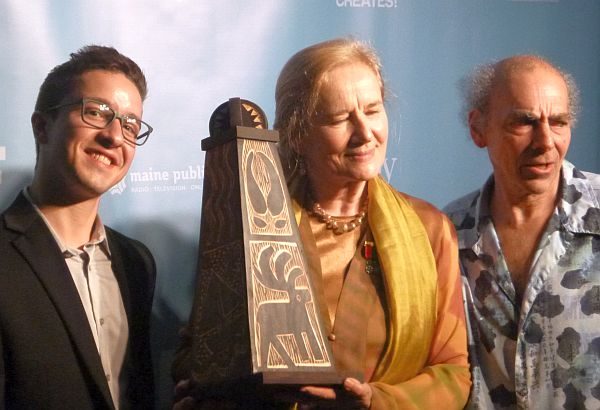
Dominique Sanda shows off her MIFF Lifetime Achievement Award, a wooden obelisk resembling a lighthouse with Maine scenes carved on the sides. Flanking her are Mike Perreault (L), Executive Director of the Maine Film Center, and Ken Eisen (R), Festival Programmer.
The Maine International Film Festival will honor French actress Dominique Sanda with its Lifetime Achievement Award in a ceremony at the Waterville Opera House on Sunday, July 15, at 6:30 p.m. Along with the presentation will be a screening of her best known film, The Garden of the Finzi-Continis, which won the Academy Award for Best Foreign Language Film in 1972.
"Dominique has a directorial filmography like no other actress," said MIFF Programming Director Ken Eisen in a press release. He noted that her first three films had "legendary directors" — The Garden of the Finzi-Continis by Vittorio de Sica, The Conformist by Bernardo Bertolucci, and Une Femme Douce ("A Gentle Woman") by Robert Bresson — and that her fourth, First Love, was directed by "legendary actor" Maximilian Schell.
Eisen continued, "The most in-demand actress of the 1970s and into the '80s, Dominique hasn't stopped making movies — covering continents as well as decades over the course of her filmmaking. She has been honored at European film festivals but never here in North America — it's a pleasure to welcome her and her fine films to MIFF this year…"
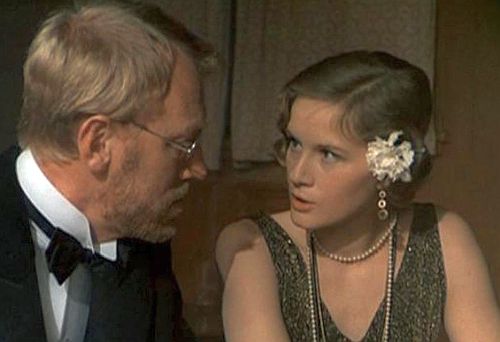
Max von Sydow and Dominique Sanda in Steppenwolf (1974).
The award presentation and screening of The Garden of the Finzi-Continis will be the festival's capstone. Based on a novel by Giorgio Bassani, the film takes the viewer into the lives of the Finzi-Continis, an aristocratic family living on a bucolic estate in 1930s Italy. Adult siblings Alberto and Micol enjoy holding parties and tennis matches with their friends, but the family is Jewish and fascism is rising. Their wealth can protect them only for so long before their idyllic world is torn asunder.
MIFF will show seven other Dominique Sanda films this year, and Sanda will introduce them all in person. They are Une Femme Douce (1969), The Mackintosh Man (1973), Steppenwolf (1974), 1900 (1976), The Conformist (1970), Going Away (2013), and The Inheritance (1976).
▲ To Table of Contents • Print Article • To Other Links ▼
Remembering Alan Charles And His Love of the Lakes

Whether you're a summer visitor, a seasonal resident, or you call it home year-round, you likely share our sentiment that the Belgrade Lakes is nothing short of Heaven on Earth. When our dad, Alan Charles, who grew up in Oakland and spent summers on Messalonskee and Salmon Lakes, found a perfect little lot on the Western shore of Great Pond, he set to work building his own little slice of heaven: a humble A-frame camp which he envisioned as a gathering place for his immediate and extended family — we, his children, were not yet a twinkle in his eye.
Designed by his cousin and architect Tom Reilly, who has his own camp on Long Pond, construction was completed on the Charles Camp in 1971, and promptly became Dad's refuge, the recreational destination of his family, and the preferred location for all summertime birthdays and celebrations.
As children, our entire summers were spent at the A-Frame, and we had the privilege of the best of "lake life." Early morning trolling off of Hoyt's for salmon, night fishing off the dock for perch, canoe paddles into the shallows, loon lullabies, watching storms drift across the lake followed by double rainbows over the island, hammock swings, building forts in the woods and OH SO MUCH SWIMMING.
So many of these experiences were quietly shepherded by Dad, who delighted in our joy while also instilling in us a reverence for the beauty and fragility of our playland. He invited us to stop and observe the natural world, and often marveled out loud about things like patterns in the water, cloud formations, the color of leaves, and would reminisce about the astounding number of loons he used to see crossing the lake in the '70s.
Dad created this little paradise for us, largely by hand in fact, but even more remarkable was his commitment to sharing it with others, and being a steward of the entire Belgrade Lakes watershed. This commitment led him to be exceptionally involved in the many organizations that work on these efforts in the Belgrade Lakes, to which he dedicated countless volunteer hours. He served on the board of the Belgrade Lakes Association (BLA) and coordinated volunteers for the annual raffle, was a volunteer inspector at area boat launches to prevent the proliferation of milfoil, joined water quality testing initiatives, and participated in the annual loon count. He was one of the first on our road to receive a LakeSmart Award, modeling practices to prevent the leaching of chemicals into the lake, and on his own volition motored all of our guests out to view "Goldie," Colby College's data buoy off of Hoyt's, initiating visitors to the importance of lake health.
In recent years, as age impeded his mobility, Dad became a fixture at the BLA raffle table in Belgrade Village, where he took on multiple weekly shifts to spread the gospel about conservation and raise money to protect his beloved lakes. He loved being an ambassador of BLA, chatting it up with fellow volunteers, and making friends with literally everyone.
Dad passed away at camp on June 16 of this year, and we, along with our camp road neighbors and all of his friends in the Belgrade Lakes feel his absence profoundly this summer. In our sadness, however, we find comfort being surrounded by the slice of heaven he left behind for us, and are proud of the diligence and care he put into leaving this world a beautiful and more protected place for generations to come. We hope that others are as inspired by his legacy as we are, and that the next time you're struck by our region's beauty, you might send a little thought up to him in thanks.
—Submitted by his children, Kymberlie and Nicholas Charles
Print Article • Go to Top of Page
A Village Stroll in 1959, Part I
In 2014 I wrote a little piece called "Things They Are a Changin'." It was in Summertime in the Belgrades and incorporated into The Luckiest Boy Season II that fall.
After starting from the bridge by the dam, we proceeded southerly through the village and viewed the homes and spoke to some owners on the Long Pond side of the street. Time ran short just after reaching the triangle where Route 27 and West Road split. It was the last Summertime story of the year so had to be left there, with good intentions to continue our stroll the next spring.
Other stories took precedence in the spring of 2015, and it is past time that we complete our journey back down to the bridge. Thanks for being patient, apparently things don't happen too fast here. We are in no rush, so our return to the dam may be a slow and wordy one.
Let's start where we left off at the triangle and cross Route 27 to what is now 39 Main Street and Hello Good Pie. After each house or building, I will tell you what exists today along with some italicized comments.
It is May, 1959 and we are standing in our little group beside a white house just south of the Catholic Church. Before we delve into a lengthy paragraph or two about the white house we are now looking at, I want to tell you about another home that is nearly hidden in the woods, sitting just south of us on a knoll directly across from the blue colored storage buildings, only seen directly from Route 27 when passing by.
It is the home of Harold and Flossie Webster, long time Belgrade residents who have raised 3 boys there, Maurice, David and John. Harold has started the Great Pond Marina down at the south end of the cove near the Belgrade Camp Ground. He builds cedar wooden boats in his cellar in the winter, is a trapper and hunter. He and his boys run the water mail route on Great Pond, and son David continued that to become the somewhat infamous mailman after the movie On Golden Pond was popular. After Harold's death, the home was eventually sold. The Zambelli family has owned the house for 40 years or so where they have brought up their children Steve and Deanna there. The campground I spoke of is now the location of the newer Belgrade Community Center which replaced an earlier version near the current fire station, just south of the village.
While still standing in the same spot, we ponder the path entrance to the home of my Uncle Albert and Aunt Lydia Johnson. It is spring, and they have just returned from their winter migration to Florida. Their turquoise and white 1957 Chevrolet station wagon sits on the lawn next to the Catholic Church as they pick away at unloading it from the long trip home. They were one of the first families to leave Belgrade in the winter looking for some steady employment until Spring returned. They have been doing the snow bird migrations since 1952. Lydia and Albert have three children, Cary, Carol and Chris, who is a newborn this year. They will open their gift shop, The Brass Knocker, that consumes most of the first floor rooms in their house, and get ready for the tourist season. Albert will do camp work and sell fishing bait from their cellar to make ends meet, as well as help Lydia with setting up the gift shop. They both have endless energy and work until midnight many nights.
After a few welcoming words with the Johnson family we migrate along to see what is next on our hit list, though the history of this family could occupy many hours of chatting. My grandfather Ernest and two of his sons, my father Clifford and uncle Albert built the house after WWII in 1948-1949.
Ernest was getting along in years and died in 1952, but cut every stick of lumber for the entire house with a hand saw, as the two younger sons nailed it together. You may admire the house as a simple cape with acorn dormers on the street side and a wooden fan painted black over the front entrance. (Grampa J. built the fan as Lydia had always coveted the idea of having one over the door).
The gift shop was moved to space in the Village Inn for 20 seasons or so, and eventually came home to roost at 39 Main Street, but in a newly built separate building now occupied by Hello Good Pie. You may know the property as the Brass Knocker Gift Shop where the dressed geese resided on the lawn some years back and today we know it as 39 Main Street, a bed and breakfast, also an evening eatery. The smaller building is occupied by Hello Good Pie.
Lydia and Al continued their migrations until Al passed away in 1998 and Lydia continued until her death in 2011 at the age of 93. She amassed a total of 62 consecutive years of living in Belgrade Lakes and Boca Raton, Florida. We barely scratched the surface here of the family or the house. For more on this ask Cary, Carol or Chris Johnson some day when you both have lots of time.
Note: We are just getting started and hope you follow us weekly until we have finished our journey.
Print Article • Go to Top of Page
Destiny and Power

Let's celebrate all summer long President George H.W. Bush's 94th year here, most every summer for him spent at Walker's Point, Kennebunkport, Maine. His love of the family place and bringing world leaders there to share tennis, fast golf games, and even faster speed boat rides are legendary.
When historian Jon Meacham spoke at Barbara's memorial service in Texas recently, I came to realize that Meacham was the official biographer of our very respected 41st president. Even for the crowds attending his wife's funeral, President Bush was out there greeting children and parents with his beloved daughter "Doro" at his side. [Barbara Bush passed away in April, at age 92.]
Upon his arrival in Maine for this summer without Barbara, President Bush attended the local pancake breakfast and ended up hospitalized a few days. Apparently he likes to party too much, according to a news report! Such a dynamic man, even from his wheelchair.
I bought the $20 paperback, only 601 pages, but readers of biography will find this book one of the finest. Maybe because I like President Bush One, I call him, to differentiate his office from his son's…maybe because Barbara Bush always charmed the press, maybe because we all agree Maine is the best place for summer!
During our recent presidential campaign, it was Barbara Bush who said that voters were tired of both the Clintons and the Bushes. How wise she was. How smart of George to find her at a college party when Barbara was visiting from her Ashley Hall School in Charleston, SC. How young they were to promise early marriage and off he went as the youngest pilot in WWII.
The 21 locations shown on a double-page map really brings to mind how important Kennebunkport, Maine was during his many moves in a constantly changing political life. I also had this same impression when reading the life of JFK, a much shorter life, cut off by an assassin. Vacation homes seem to anchor us as ordinary people and also leaders like JFK and the Bushes, both father and son.
It really amazed me to read that Barbara had recurring depression. She naturally experienced this when their dear daughter Robin died of leukemia. Later, however, when Bush was head of the CIA, Barbara had a six month rough patch where her husband constantly supported her and urged counseling. Somehow, she luckily snapped out of it, as Barbara has remarked publicly.
People who are so very public and privileged as the Bush family certainly guide us in our own lives. I look at the map of so many moves and think how lucky I have been to not move so often.
Summer in Maine is our common ground whether we live stable lives or move around a lot.
When George was Vice President, our family happened to be at a motel up above Walker's Point. We looked out from the balcony as a few Secret Service trotted by while Bush had his morning jog. There he was running the narrow road along the gorgeous rocky coast. The Coast Guard boat was out in the ocean guarding with our American flag waving. Later we stopped for a meal at the local lobster shack.
All of a sudden, the tiny restaurant was invaded by suits and ties, not usual attire for Maine vacationers. They looked around and went back to the kitchen. Soon, in walks the lovely, white-haired Barbara and a few friends…since 9/11, I suppose it is all too complicated to explain security.
Riding bicycles in China by both Bushes impressed me. What an adventure they had there and finally their son George travelled abroad to visit his parents. Color photos reveal how happy they were serving in China for two years.
As newlyweds, George and Barbara were quite of one mind to move from New England roots to the wilds of Odessa, Texas. Care packages from Barbara's mother included laundry detergent and other necessities, maybe not available out there on the frontier! Midland, TX and Houston became their roots, but Maine was the place for SUMMER.
Sometimes it is fun to read the index of a huge biography like this one. Just look up Kennebunkport and read all the Maine antics. Have fun celebrating with me President Bush's 94th year with practically every single summer of his well-lived life in our favorite state of Maine.
Print Article • Go to Top of Page
So What Is Erosion Control Mulch?
In 2001, the Maine Department of Environmental Protection developed ECM specifications:
Erosion control mix/mulch can be manufactured on or off the project site. It shall consist primarily of organic material [at least over 20%], and may include: shredded bark, stump grindings, composted bark. Wood chips, ground construction debris, reprocessed wood products or bark chips will not be acceptable as the organic component of the mix/mulch.
Erosion control mix/mulch shall contain a well-graded mixture of particle sizes and may contain rocks less than 6″ in diameter. 70-85% of the stone mix should be less than ¾″ stone.
Erosion control mix must be free of refuse, physical contaminants, and material toxic to plant growth. DEP no longer has a specific standard posted.
This week I'll try and focus on using Erosion Control Mulch to slow down stormwater runoff. For those of you familiar with the LakeSmart program this will seem familiar.
A couple weeks ago I was already talking about the importance of slowing down stormwater. Sometimes it is difficult to use vegetation, whether that is ground cover, low growing plants, shrubs or trees. So… what to do then?
First try and let the natural duff collect in your yard and beneath your plants. It helps to slow runoff and soften the impact of water droplets to protect the soils beneath. If you can, only maintain the needed pathways and open areas which you use. Many of us have more open space around the buildings and driveways than we use. Let it return to a relatively natural state. I've seen yards where people have swept the pine needles and other duff into piles and left the bare ground exposed. Avoid this type of practice. It can lead to stormwater runoff that is not impeded at all.
As I noted a couple weeks ago, mulch can best be used with your vegetative buffers. Erosion Control Mulch (ECM) is the better type of mulch. Mulching is one of the most effective and cost efficient Best Management Practiceswe should work with. For stabilizing construction sites, eroded banks, and top dressing buffer plantings, almost any type of mulch helps. But for establishing a better stormwater control practice Erosion Control Mulch is better to protect water quality.
Most people will buy their ECM from a contractor. Make sure you actually get what you intend to use. Mulch comes in many textures and colors. Don't confuse "compost", "conservation mulch", "bark mulch" and "wood chips" with ECM. Erosion Control Mulch (ECM) was developed to protect soil from erosion in areas that receive high traffic, exposure to the elements or occur on steep slopes. ECM, sometimes called slope stabilizer, is not your standard landscape bark mulch. ECM is "chunky". ECM traps plenty of moisture, similar to standard bark mulch but can remain stable on steeper slopes. Thickness of application can vary depending upon several factors but 4-6″ is average. Sites with extreme exposure to wind and water may need more while mulch berms may be 18-24″ tall/thick.
When bare soil is exposed to the elements, erosion begins to occur. Rain and wind can remove topsoil very quickly and deposit soil particles in the water. As these particles are transported in stormwater, they act like little magnets picking up pollutants and nutrients along the way. Once in the lake (or river or stream) these pollutants are deposited. Result — problems including algae blooms and elevated levels of toxins.
Erosion Control Mulch, when properly installed, can be part of the solution for your property. Remember, there is a lot to do in order to protect water quality.
Now retired, Dale Finseth was executive director of the Kennebec County Soil & Water Conservation District from 2001 to 2024.
Print Article • Go to Top of Page
Fishing and Hiking and Kids' Camps

Tom McCandlish after netting a nice Long Pond bass.
This past week included some record-setting heat that resulted in a lot of water-based activities over the Fourth of July. One of my daughters, her husband, and a couple of friends came to hang out by the lake. My son-in-law, Taber, rode his bicycle up from Brunswick that morning and was in the lake with a cold drink within minutes of reaching the house.
Last week I talked a bit about the importance of our local sporting camps to our lake community. Another set of camps that introduces new visitors to our area are the youth camps that bring in not only the kids but also their parents. Some of these camps have been on our lakes for more than a century (e.g. Pine Island Camp, and Camp Runoia) and many of their alumni have retired here. Other camps include Pine Tree Camp on North Pond, Camps Matoaka and Manitou on East Pond, Camps Tracy and Modin on McGrath Pond/Salmon Lake, New England Music Camp on Messalonskee, and the Boy Scouts' Camp Bomazeen on Great Pond. Even camps that don't exist anymore such as the former tennis camp on Taconnet Island and former Camp Kennebec on Salmon Lake have sizeable populations of alumni that have settled permanently in our community with friends they have known for decades.
Good water quality is important to all these groups and they are all strong supporters of the local lake associations, and other conservation organizations such as the 7-LA (former BRCA and MLRC). Each of these groups brings a different wrinkle to our unique community and a slightly different sense of place but all help make our community a special place. One day last week I met 30 campers and counselors from Camp Modin, hiking at Mount Phillip, a property that is now permanently conserved thanks to the 7-LA and alumni of Pine Island Camp.
I managed to get out fishing a bit, including a trip on Long Pond with fellow 7-Lakes Alliance Board Member, Tom McCandlish, who has been coming to Great Pond since 1959, first as a Bear Springs camper with his parents, and since the mid-80s as a camp owner on Mountain Drive. We caught several nice fish, including a roughly 30" pike that I managed to land on my ultralight spinning rig despite the lack of a wire leader. Luckily the fish was hooked at the tip of snout and couldn't bring its sharp teeth to bear on my 4 lb. test line. My friend, Dick Greenan, had his son, Jason, daughter-in-law, Devon, and a couple of grandkids visiting for the week. Dick led a successful canoe/kayak fishing trip down the Kennebec River from Waterville to Sidney.
This area offers some great outdoor recreation, whether you like to hike, bike, birdwatch, fish, sail, or paddle a canoe or kayak. Pick up a map of the local trails at Day's Store or from the 7 Lakes Alliance at the Maine Lakes Resource Center. Also, please check the 7-LA FaceBook page for details on some interesting events scheduled this summer. And make sure you take a kid along on your next outdoor adventure.
Print This Article • Print All Articles • Go Back To Top of Page

Download the Print Edition
The print edition includes all the above articles and much more. You can find a complete table of contents on p. 3. Adobe Reader is required.
◀— Previous Issue • All 2018 Issues • Archives • Business Directory • About Us • Home • Next Issue —▶
